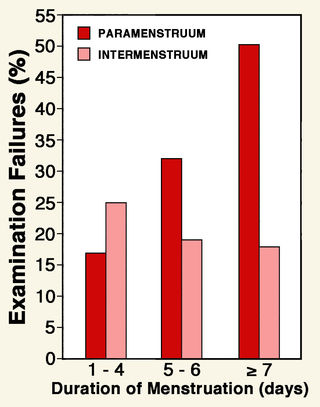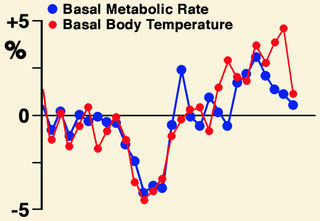Hormones
Coping With Hormonal Ups and Downs
Assessing the burden of a woman’s monthly cycle
Posted October 17, 2016

Women around the world use more than 5,000 different code names for menstruation. This emerged from an international survey of over 190 countries conducted in November 2015 by Clue (provider of a free cycle-tracking app) jointly with the International Women’s Health Coalition. French euphemisms have been particularly inventive, ranging from the epicurean “Le Beaujolais Nouveau est arrivé” to the chauvinistic “les anglais ont debarqué” (“the English have landed”). Such coyness stems from the taboo status of menstruation, reinforced by certain religious teachings that it is “unclean.” Because of this murky background, little research has been conducted on physiological and behavioral concomitants of menstrual cycles. A striking example of such neglect is the relative scarcity of studies exploring relationships between menstrual cycles and performance in male-biased sports medicine. But this is also a sensitive topic. While recognition of genuine side-effects of women’s monthly cycles is needed for effective intervention, mere mention of fluctuating performance can easily lead to even more discrimination against women.
Early research on menstrual cycles

Serious studies of the relationship between hormones and psychology across the human menstrual cycle began some 80 years ago with a 1937 paper headed up by Robert McCance and Elsie Widdowson. Using questionnaires, these authors conducted a 6-month survey of 167 educated women—doctors, nurses, teachers, research workers, students. Typically for the times, they encountered opposition. Some medical school heads “took exception to forms on the grounds that sexual feeling was abnormal in unmarried women students and that no forms containing such words could possibly be allowed to circulate in their institutions.” Strikingly, about 90% of women reported pain accompanying menstruation. Although the McCance/Widdowson survey was primarily designed to investigate the relationship between cycle stage and sexuality, it also assessed variation in fatigue, abdominal pain, headache, depression, elation, crying tendency, irritability and intellectual capacity, all of which tended to peak around menstruation. Taking the evidence as a whole, McCance and Widdowson concluded that menstruating women may experience a real reduction in performance capacity.
A hormonal rollercoaster?

In stark contrast to men, from puberty to menopause women undergo monthly cycles accompanied by marked hormonal changes. Each cycle ends with menstruation—more than a fluid ounce of blood typically lost over 4-5 days. (See my August 6, 2014 post The First Curse on Women: Menstruation.) In the first half of the cycle, several starter follicles begin to develop in both ovaries, and one will eventually mature to egg release (ovulation) on about day 14. A steady rise in oestrogens characterizes this follicular phase. Soon after oestrogens peak, a surge in luteinizing hormone (LH) triggers ovulation. The remnant of the follicle then forms a progesterone-producing corpus luteum (yellow body) that persists until menstruation. During the second half of the cycle, the luteal phase, a secondary rise in oestrogens occurs.
Numerous studies have examined the possibility that behavioral and psychological side-effects are likely to result directly from the substantial hormonal changes during a woman’s menstrual cycle, although the main focus has been on fluctuating sexuality. But note that a major change accompanied the evolution of higher primates (monkeys, apes and humans): Hormonal influences on behavior declined whereas brain control increased. So great caution is needed when seeking direct links between women’s capacities and their hormones.

A towering figure in the investigation of side-effects of menstrual cycles is Katharina Dalton (1917-2004). Her work made the Premenstrual Syndrome (PMS) a household name, through her influential 1964 book that ran into five editions, ending with Once a Month: The Original Premenstrual Syndrome Handbook (1994). Dalton’s initial research examined relationships between menstruation and accidents, crimes or examination failures. One of her best-known papers, published in 1968, reported that schoolgirls are more likely to menstruate during exam periods and that the failure rate is higher during menstruation than other cycle stages. PMS affects three out of four women at least to some degree, and Dalton herself suffered debilitating premenstrual migraine headaches. Her attention was particularly drawn to the hypothesis that an unusually steep decline in progesterone before menstruation triggers the adverse symptoms experienced by many women. Dalton rapidly became an advocate of progesterone therapy to combat PMS. But nothing in biology is ever simple, so it is inherently unlikely that a single hormonal factor such as progesterone governs the syndrome. Nowadays treatment relies more on SSRIs (selective serotonin reuptake inhibitors), but progesterone is probably involved as well. At least two studies have shown that extracts from chasteberry—a plant producing a progesterone-like substance—reduce the symptoms of PMS.
Menstruation and performance

Some women are clearly temporarily incapacitated by PMS, but for other cycle stages direct links to hormone levels and performance are far less evident. Nonetheless, there is a striking change in energy turnover across the cycle. Indeed, an allied feature has long served as an approximate indicator of ovulation time: basal body temperature (BBT; the minimal level while resting). Soon after ovulation, at the transition from the follicular to the luteal phase, a woman’s BBT typically shifts upward by about 0.5°C. That raised level is then maintained for the rest of the cycle. A 1938 paper by Boris Rubenstein reported that basal metabolic rate (BMR; energy consumption while resting) and BBT show very similar patterns. So a woman’s fundamental energy needs are higher during the luteal phase than in the preceding follicular phase.

Higher energy turnover during the luteal phase of the menstrual cycle connects up with evidence from studies indicating that a woman’s food intake also varies cyclically. For instance, a 1995 paper by Heidi Danker-Hopfe and colleagues reported variations in food intake across the cycles of 27 healthy women, using BBT to track ovulation. It emerged that total energy intake is generally higher in the luteal than the follicular phase. Carbohydrate intake was lowest around mid-cycle, reaching a minimum about 2 days after ovulation, and fat intake showed a comparable trough. The study also revealed that subjective perception of "sweetness" was highest during the luteal phase. Hot tip: To get the biggest bang for his buck, any suitor should ply the woman of his dreams with chocolates between ovulation and menstruation.
Several studies of non-human primates have similarly revealed a connection between food intake and menstrual cycle phase. In 1980, for example, Howard Rosenblatt and colleagues reported observations of Rhesus macaques in which menstrual cycles were tracked with hormone assays (LH, FSH, oestrogens, progesterone). The monkeys consumed more food in the luteal phase than during the early follicular phase, and the amount eaten decreased significantly at the time of the LH surge in mid-cycle.
Menstrual cycles and sports training
Apart from cases with clear medical issues, studies of female athletes have shown only subtle differences according to cycle stage. An example is provided by a PhD study recently completed by Lisbeth Wikström-Frisén at Umeå University in Sweden. Her research examined the effectiveness of leg resistance training in relation to menstrual cycle phase. She studied two experimental groups of 19 women, with women in group 1 training intensively every weekday during the first half of each cycle and those in group 2 training intensively every weekday during the second half. In a control group containing 21 women, regular leg resistance training was performed 3 times a week across the cycle. Although all groups were similar in many respects, a key finding of the research was that intensive training during the follicular phase of the cycle showed significant benefits, notably increased lean body mass, compared with intensive training in the luteal phase or even regular training spread across the menstrual cycle.
But it is important to emphasize that female athletes cope remarkably well with the marked hormonal changes across their menstrual cycles. In a number of studies, Barbara Sommer has shown that few statistically significant differences in performance have been found according to cycle stage, and that social expectations regarding mood states and cognition can have pronounced effects. Quite rightly, she has emphasized that unfounded notions of “menstrual debilitation” can work against women’s interests.
References
Clue survey of menstruation: http://www.helloclue.com/survey.html
Dalton, K. (1961) Menstruation and crime. British Medical Journal 2(5269):1752-1753.
Dalton, K. (1968) Menstruation and examinations. Lancet 292:1386-1388.
Dalton, K. (1994) Once a Month: The Original Premenstrual Syndrome Handbook (Fifth Edition). San Bernhardino, California: The Borgo Press.
Danker-Hopfe, H., Roczen, K. & Löwenstein-Wagner, U. (1995) Regulation of food intake during the menstrual cycle. Anthropologischer Anzeiger 53:231-238.
McCance, R.A., Luff, M.C. & Widdowson, E.E. (1937) Physical and emotional periodicity in women. Journal of Hygiene 37:571-611.
Pliner, P. & Fleming, A.S. (1983) Food intake, body weight, and sweetness preferences over the menstrual cycle in humans. Physiology & Behavior 30:663-666.
Rosenblatt, H., Dyrenfurth, I., Ferin, M. & Vande Weile, R.L. (1980) Food intake and the menstrual cycle in rhesus monkeys. Physiology & Behavior 24:447-449.
Rubenstein, B.B. (1938) Estimation of ovarian activity by the consecutive-day study of basal body temperature and basal metabolic rate. Endocrinology 22:41-44.
Schellenberg, R. (2001) Treatment for the premenstrual syndrome with agnus castus fruit extract: prospective, randomised, placebo controlled study. British Medical Journal 322:134-137.
Sommer, B. (1992) Cognition and the menstrual cycle. pp. 39-66 in: Cognitive Performance and the Menstrual Cycle (ed. Richardson, J.T.E.). New York: Springer.
Wikström-Frisén, L. (2016) Training and Hormones in Physically Active Women With and Without Oral Contraceptive Use. PhD Thesis. Umeå Universitet, Umeå.




